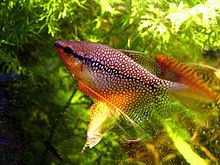bio.wikisort.org - Animal
The pearl gourami (Trichopodus leerii) is a species of gourami native to Southeast Asia.[2]
| Pearl gourami | |
|---|---|
 | |
Conservation status | |
| Scientific classification | |
| Kingdom: | Animalia |
| Phylum: | Chordata |
| Class: | Actinopterygii |
| Order: | Anabantiformes |
| Family: | Osphronemidae |
| Genus: | Trichopodus |
| Species: | T. leerii |
| Binomial name | |
| Trichopodus leerii (Bleeker, 1852) | |
| Synonyms | |
| |

Description
It reaches about 12 centimetres (4.7 in) TL.[2] Its body is a brownish-silver colour, covered in a pearl-like pattern with a distinct black line running from the fish's head, and gradually thinning towards the caudal fin. The pearl gourami's appearance has given rise to other popular names, such as the lace gourami and the mosaic gourami.
Its male specimens, typical of many gouramis, are generally larger and more colourful than their female counterparts. They exhibit bright orange colouring around the throat region, which at breeding time becomes much brighter and is used to court the female. Males also exhibit somewhat of an orange tinge in their fins, with the exception of the caudal (tail) fin. The male also has longer fins, with a more pointed dorsal fin and extended anal fin rays.[3]
Distribution and habitat
The pearl gourami is native to Thailand, Malaysia and Indonesia (where it is found on the islands of Sumatra and Borneo). It occurs in lowland swamps with acidic water.[2]
Species description and name
Trichopodus leerii was originally described as Trichopus leerii by the Dutch medical doctor and ichthyologist Pieter Bleeker in 1852. The type was collected at Palembang in Sumatra,[4] by Lieutenant-Colonel J. M. van Leer, who was a medical colleague of Bleeker's and whom Bleeker honoured in the fish's specific name.[5]
References
- Low, B.W. (2019). "Trichopodus leerii". IUCN Red List of Threatened Species. 2019: e.T187958A91316190. doi:10.2305/IUCN.UK.2019-2.RLTS.T187958A91316190.en. Retrieved 20 November 2021.
- Froese, Rainer; Pauly, Daniel (eds.) (2014). "Trichopodus leeri" in FishBase. February 2014 version.
- Sanford, Gina (1999). Aquarium Owner's Guide. New York: DK Publishing. ISBN 0-7894-4614-6.
- Eschmeyer, William N.; Fricke, Ron & van der Laan, Richard (eds.). "Trichopus leerii". Catalog of Fishes. California Academy of Sciences. Retrieved 14 December 2019.
- Christopher Scharpf; Kenneth J. Lazara (21 October 2019). "Order ANABANTIFORMES: Families ANABANTIDAE, HELOSTOMATIDAE, OSPHRONEMIDAE, CHANNIDAE, NANDIDAE, BADIDAE, and PRISTOLEPIDIDAE". The ETYFish Project Fish Name Etymology Database. Christopher Scharpf and Kenneth J. Lazara. Retrieved 14 December 2019.
На других языках
- [en] Pearl gourami
[es] Trichogaster leerii
El gurami perla (Trichogaster leeri) es una especie de pez perciforme laberíntido de la familia Osphronemidae con cuerpo aplanado y alargado, de una hermosa coloración y dotado de una gran resistencia, lo que le permite alcanzar una edad de hasta 8 años. Se lo utiliza como pez de acuario.[ru] Жемчужный гурами
Жемчу́жный гура́ми[1] (Trichogaster leerii) — один из видов лабиринтовых рыб. Относится к распространённым аквариумным рыбкам. Обитает в Индии, на Малайском архипелаге, в Индонезии — на Суматре и Борнео[2], а также в Таиланде[3] в мелких, густо заросших водоёмах[3]. Самец длиной до 12 см, самка немного мельче. У самца плавники длиннее и острее, окраска ярче, грудь и брюхо, особенно в возбуждённом состоянии, оранжево-красноватые. Мирные и довольно пугливые.Другой контент может иметь иную лицензию. Перед использованием материалов сайта WikiSort.org внимательно изучите правила лицензирования конкретных элементов наполнения сайта.
WikiSort.org - проект по пересортировке и дополнению контента Википедии
